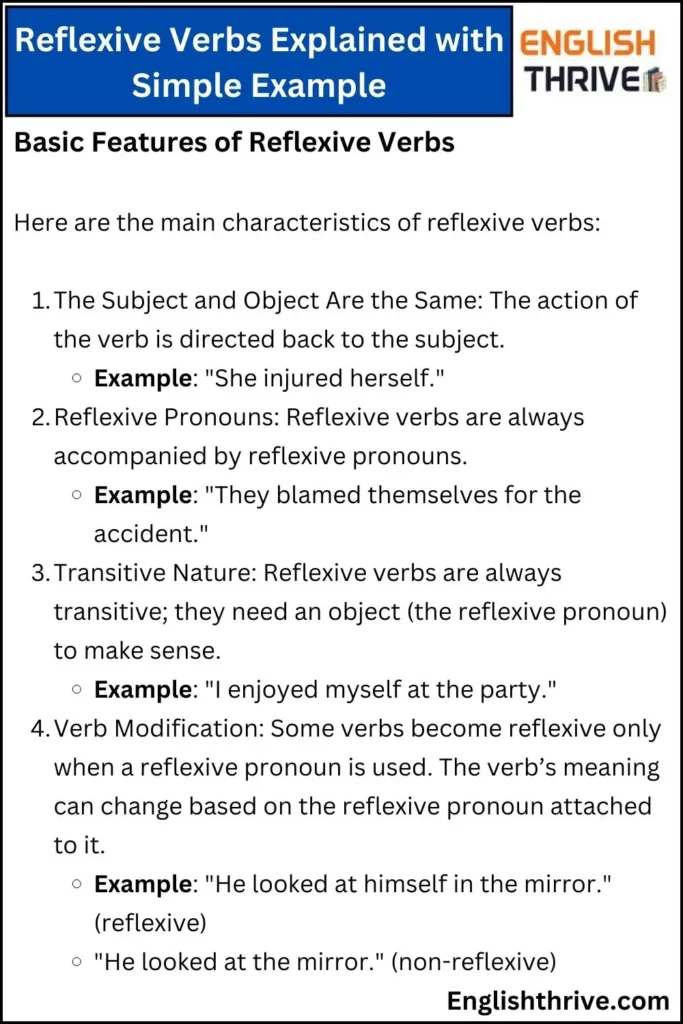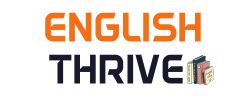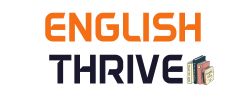Reflexive verbs are an essential part of English grammar that allows us to express actions that a subject does to itself. These verbs are commonly used in everyday conversation, and mastering them can significantly improve your fluency and precision in English. While reflexive verbs are relatively straightforward in their basic use, advanced reflexive verbs offer more nuanced expressions that can add depth to your communication.
In this article, we will explore advanced reflexive verbs, their structures, and their common uses. We will also discuss when reflexive verbs require additional elements such as prepositions and how they differ from reciprocal verbs. Whether you’re a beginner or looking to refine your skills, this guide will equip you with a deeper understanding of reflexive verbs and how to use them effectively.
Contents
ToggleWhat Are Reflexive Verbs?
A reflexive verb is a verb that indicates the subject of the sentence is performing an action on itself. In other words, the subject and the object of the action are the same. Reflexive verbs are commonly used with reflexive pronouns such as myself, yourself, himself, herself, itself, ourselves, yourselves, and themselves.
Example:
“I washed myself.”
“She taught herself to play the guitar.”
In both examples, the subject (I, she) performs the action on themselves. The reflexive pronouns reflect the subject’s involvement in the action.
Note: While reflexive verbs are often transitive, meaning they need a direct object, some can be used without an object if the meaning is clear.

Basic Features of Reflexive Verbs
Here are the main characteristics of reflexive verbs:
The Subject and Object Are the Same: The action of the verb is directed back to the subject.
Example: “She injured herself.”
Reflexive Pronouns: Reflexive verbs are always accompanied by reflexive pronouns.
Example: “They blamed themselves for the accident.”
Transitive Nature: Reflexive verbs are always transitive; they need an object (the reflexive pronoun) to make sense.
Example: “I enjoyed myself at the party.”
Verb Modification: Some verbs become reflexive only when a reflexive pronoun is used. The verb’s meaning can change based on the reflexive pronoun attached to it.
Example: “He looked at himself in the mirror.” (reflexive)
“He looked at the mirror.” (non-reflexive)
Common Reflexive Verbs
There are many verbs that are commonly used in reflexive form. Some of these verbs are regularly used in everyday English conversations, while others are more formal or used in specific contexts. Below is a list of some of the most frequently used reflexive verbs:
Enjoy oneself – “We really enjoyed ourselves at the concert.”
Blame oneself – “He blamed himself for the mistake.”
Teach oneself – “She taught herself how to cook.”
Introduce oneself – “I’d like to introduce myself.”
Hurt oneself – “Be careful not to hurt yourself while handling those tools.”
Prepare oneself – “The actor prepared himself for the role.”
Express oneself – “He expresses himself through his art.”
Apply oneself – “If you apply yourself, you’ll succeed.”
Adapt oneself – “She adapted herself to the new environment quickly.”
Relax oneself – “I need to relax myself after a busy week.”
These verbs are versatile and often used in daily life. They express personal involvement in actions or states, such as enjoying something, blaming oneself, or relaxing.
Reflexive Verbs with Prepositions
In English, some reflexive verbs require prepositions to fully express their meaning. The preposition complements the action and provides additional context. In these cases, the preposition is placed between the verb and the reflexive pronoun.
Here are a few examples of reflexive verbs with prepositions:
Talk to oneself – “I often talk to myself when I’m thinking.”
Look at oneself – “She looked at herself in the mirror.”
Boast about oneself – “He’s always boasting about himself.”
Think of oneself – “I like to think of myself as a patient person.”
Laugh at oneself – “He can laugh at himself even in difficult situations.”
Worry about oneself – “She tends to worry about herself too much.”
Care for oneself – “It’s important to care for oneself.”
Speak about oneself – “He doesn’t like to speak about himself.”
These expressions are important to learn because they often convey deeper emotional or social meanings, such as self-reflection, self-criticism, or self-confidence.
Advanced Reflexive Verbs and Their Usage
In addition to the common reflexive verbs, there are advanced reflexive verbs that can be used in more specific contexts. These verbs often carry a sense of self-improvement, self-awareness, or personal responsibility. Here are a few examples:
Blame oneself for – “She blamed herself for the failure.”
Accuse oneself of – “He accused himself of not working hard enough.”
Pride oneself on – “She prides herself on her punctuality.”
Confide in oneself – “Sometimes, we need to confide in ourselves to make difficult decisions.”
Reconcile with oneself – “After the argument, he needed time to reconcile with himself.”
Convince oneself – “He convinced himself that the decision was right.”
Deceive oneself – “Don’t deceive yourself into thinking it’s an easy task.”
These advanced reflexive verbs provide more complex structures for expressing personal thoughts, feelings, and actions. They are used when describing deeper aspects of self-reflection, self-criticism, or personal development.
Reflexive Verbs vs. Reciprocal Verbs
It is important to distinguish between reflexive verbs and reciprocal verbs. While both involve actions that reflect a relationship between subjects, they are used differently in English.
Reflexive Verbs: The action is performed by the subject on itself.
Example: “She dressed herself.”
Reciprocal Verbs: The action is performed mutually between two or more subjects.
Example: “They hugged each other.”
In reciprocal verbs, the action is shared or exchanged between two or more subjects. For reflexive verbs, the action is solely performed by and on the subject.
Reflexive Verbs in Different Tenses
Reflexive verbs are not limited to a single tense. Understanding how they are used in different tenses allows for greater flexibility and more accurate expression in both spoken and written English. In this section, we’ll cover how reflexive verbs work in various tenses, including the present, past, and future.
Reflexive Verbs in the Present Tense
In the present tense, reflexive verbs indicate actions that are occurring right now, involving the subject performing the action on themselves. The reflexive pronoun follows the verb, as in the examples below:
Example 1: “I wash myself every morning.”
Example 2: “She enjoys herself at the party.”
The present tense is used to describe routine actions or ongoing situations, making reflexive verbs an important part of daily conversation.
Reflexive Verbs in the Past Tense
When reflexive verbs are used in the past tense, they describe actions that happened in the past where the subject performed the action on themselves. The auxiliary verb “did” is often used in questions or negative sentences, while the regular past tense of the verb is used in affirmative sentences.
Example 1: “He hurt himself while playing soccer.”
Example 2: “They enjoyed themselves at the concert last night.”
In negative or question forms, the auxiliary verb “did” is used:
Example 1: “Did she blame herself for the mistake?”
Example 2: “I didn’t apply myself during the exam.”
Reflexive Verbs in the Future Tense
In the future tense, reflexive verbs are used to talk about actions that will occur later, where the subject will perform the action on themselves. The auxiliary verb “will” is used to form the future tense in reflexive verb constructions.
Example 1: “We will prepare ourselves for the challenge ahead.”
Example 2: “She will blame herself if things go wrong.”
By using reflexive verbs in the future tense, speakers can express self-involvement in actions that are expected to happen.
Reflexive Verbs in Continuous and Perfect Tenses
Reflexive verbs can also be used in continuous and perfect tenses, providing more specific information about ongoing actions or completed actions involving the subject.
Present Continuous Tense: This tense expresses actions that are happening right now or temporary actions.
Example: “I am enjoying myself at the moment.”
Present Perfect Tense: Used to describe actions that have been completed at some point before the present moment.
Example: “She has taught herself how to cook.”
Past Continuous Tense: Indicates that an action was ongoing in the past.
Example: “He was blaming himself for the delay.”
Past Perfect Tense: Describes an action that was completed before another action in the past.
Example: “They had prepared themselves for the worst.”
Future Continuous Tense: This tense is used to describe actions that will be ongoing in the future.
Example: “I will be enjoying myself on vacation next week.”
Future Perfect Tense: Used to express an action that will be completed before a certain time in the future.
Example: “By the time you arrive, I will have adapted myself to the new schedule.”
Using reflexive verbs across various tenses helps to express not just the action itself, but also the time and nature of the action.
Common Mistakes with Reflexive Verbs
While reflexive verbs are easy to use once you understand the basic structure, there are common mistakes that English learners often make. Here are a few errors to watch out for:
1. Using Reflexive Verbs Without a Reflexive Pronoun
A common mistake is omitting the reflexive pronoun when it is needed. Reflexive verbs are not complete without their reflexive pronouns.
Incorrect: “She looked at in the mirror.”
Correct: “She looked at herself in the mirror.”
Always make sure that reflexive verbs are followed by the appropriate reflexive pronoun.
2. Using Reflexive Pronouns with Non-Reflexive Verbs
Some verbs are not reflexive, so they should not be paired with a reflexive pronoun.
Incorrect: “I enjoyed myself the movie.”
Correct: “I enjoyed the movie.”
Enjoying a movie, for example, is not an action directed at oneself, so no reflexive pronoun is needed.
3. Confusing Reflexive and Reciprocal Verbs
As discussed earlier, reciprocal verbs express actions that are mutual between two or more subjects. It’s important not to confuse reflexive verbs with reciprocal verbs, which often use “each other” or “one another.”
Incorrect: “They hugged themselves after a long time apart.”
Correct: “They hugged each other after a long time apart.”
4. Incorrect Reflexive Pronoun Use with Modal Verbs
When using modal verbs (such as can, should, must, etc.) with reflexive verbs, the reflexive pronoun still needs to be used correctly.
Incorrect: “You must learn yourself how to dance.”
Correct: “You must learn yourself how to dance.”
Ensure that the reflexive pronoun is placed after the verb, even when using modals.
FAQs On Reflexive Verbs
1. What are reflexive verbs with examples?
Reflexive verbs are verbs in which the subject and the object of the action are the same. The subject performs the action on itself, and these verbs are typically paired with reflexive pronouns like myself, yourself, himself, herself, itself, ourselves, yourselves, and themselves.
Example 1: “I washed myself.”
In this sentence, “I” (the subject) performed the action of washing on “myself” (the object).Example 2: “She introduced herself to the class.”
Here, “She” performed the action of introducing on “herself.”
Reflexive verbs reflect the action back to the subject, which is what makes them unique in sentence construction.
2. What are the 10 examples of reflexive verbs?
Here are 10 common reflexive verbs in English, each with an example sentence:
Enjoy oneself – “They enjoyed themselves at the party.”
Blame oneself – “He blamed himself for the mistake.”
Introduce oneself – “I introduced myself to the group.”
Hurt oneself – “Be careful not to hurt yourself.”
Prepare oneself – “He prepared himself for the interview.”
Teach oneself – “She taught herself how to play the guitar.”
Relax oneself – “I need to relax myself after a long day.”
Express oneself – “She expresses herself through writing.”
Blame oneself – “She blamed herself for the failure.”
Adapt oneself – “He adapted himself to the new environment.”
These reflexive verbs help to describe actions that a subject does to themselves, either physically or emotionally.
3. What are 10 reflexive verbs in French?
Reflexive verbs in French are similar to those in English but are used more frequently. The reflexive pronoun changes depending on the subject. Here are 10 reflexive verbs in French, along with examples:
Se laver (to wash oneself) – “Je me lave les mains.” (I wash my hands.)
Se lever (to get up) – “Elle se lève tôt.” (She gets up early.)
S’habiller (to dress oneself) – “Nous nous habillons rapidement.” (We dress quickly.)
Se réveiller (to wake up) – “Il se réveille à sept heures.” (He wakes up at seven.)
Se coucher (to go to bed) – “Ils se couchent tard.” (They go to bed late.)
Se souvenir (to remember) – “Je me souviens de toi.” (I remember you.)
Se détendre (to relax) – “Elle se détend après le travail.” (She relaxes after work.)
Se préparer (to prepare oneself) – “Je me prépare pour la réunion.” (I prepare myself for the meeting.)
Se fâcher (to get angry) – “Il se fâche facilement.” (He gets angry easily.)
Se sentir (to feel) – “Elle se sent fatiguée.” (She feels tired.)
These verbs use reflexive pronouns like me, te, se, nous, and vous depending on the subject of the sentence.
4. Can reflexive verbs be used without reflexive pronouns?
No, reflexive verbs must always be used with a reflexive pronoun, as it indicates that the action is directed back toward the subject. Without the reflexive pronoun, the meaning of the sentence changes, and the verb no longer becomes reflexive.
Correct: “I dressed myself.”
Incorrect: “I dressed.”
In the incorrect sentence, the verb “dressed” loses its reflexive meaning and would require a direct object (like “I dressed the child”). Reflexive verbs without reflexive pronouns do not reflect the action back to the subject.
5. Are there any non-reflexive verbs that become reflexive?
Yes, some non-reflexive verbs can become reflexive depending on the context. This change often occurs when the action is performed on the subject, either physically or emotionally.
Example 1: “I wash the car.” (Non-reflexive, action on the car)
Example 2: “I wash myself.” (Reflexive, action on the subject)
Some verbs like “look” and “listen” can be made reflexive to emphasize personal involvement in the action:
Look at oneself – “She looked at herself in the mirror.”
Listen to oneself – “He listened to himself talk.”
In these cases, the reflexive pronouns are used to emphasize that the subject is directly involved in the action.
Conclusion On Reflexive verb
Reflexive verbs are a powerful tool in English grammar, allowing us to express actions that are done by the subject to itself. While reflexive verbs are relatively simple to understand, advanced reflexive verbs and their combinations with prepositions can add nuance and depth to your language use.
Mastering reflexive verbs will improve your ability to describe personal actions and emotions more effectively. From expressing self-awareness to describing routine tasks, reflexive verbs are key components of fluent and natural English.
Make sure to practice these verbs in real-life conversations and writing, as this will help you gain confidence in using them appropriately. With time and attention, reflexive verbs will become an integral part of your English language skills.
Meta Description: Master advanced reflexive verbs in English with this comprehensive guide. Learn how reflexive verbs work, including examples, common combinations, and how to use them effectively in conversation and writing.

